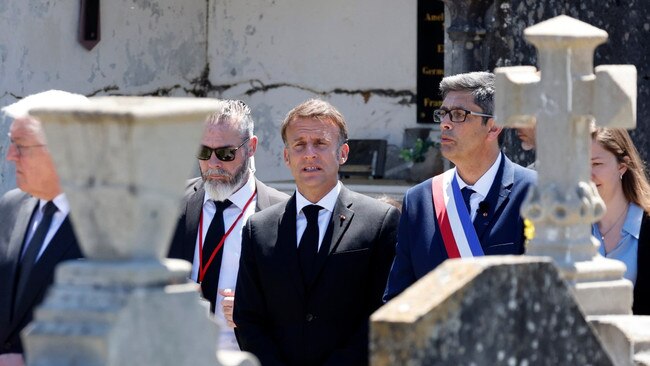French president Emmanuel Macron bets future on rousing the Nazi past
The French president resurrected wartime pain in a bid to link a massacred village with Marine Le Pen’s hard-right party.

On the sunny afternoon of June 10, 1944, between 120 and 200 German soldiers of the 2nd SS Panzer Division Das Reich entered the French village of Oradour-sur-Glane near Limoges and murdered 643 of its inhabitants.
Last week, President Emmanuel Macron travelled to Oradour just hours after announcing a snap legislative election aimed at stopping the march of the hard-right National Rally party, an act of thumping symbolism intended to invite comparisons between Marine Le Pen’s ultra-right-wingers and the fascism of an earlier era at a time when the far right is gaining ground across Europe.
“In the ashes of Oradour, we must ensure that the sap of our European project, our desire for liberty, equality and fraternity, is reborn,” Macron declared.
Calling the surprise election was a bold move, but invoking the ghosts of Oradour is also a gamble. Because the story of this infamous massacre is not a simple one, nor straightforwardly heroic. It is a tale of Nazi atrocity, to be sure, but also one of collaboration, betrayal, inadequate justice, enduring mystery and the suppression of painful memory.
A lifetime after it ended, the war still haunts France, a source of enduring guilt, confusion and controversy.
In 1944, Oradour-sur-Glane was a tranquil rural town of some 150 homes, 15 cafes, a girls’ school, baker and butcher. Its inhabitants had survived the war, as most French citizens did, by keeping their heads down and waiting for the German occupation to pass. Then the SS detachment arrived, under the command of SS-Sturmbannfuhrer (Major) Adolf Diekmann, and set about the systematic slaughter of its population. The men were herded into separate barns, machinegunned in the legs to prevent escape and then burnt. Some 241 women and 209 children were packed into the church, locked inside and then immolated by exploding an ammunition box behind the altar. Only six people escaped. The village was razed to the ground.
After the war, Oradour was preserved in its state of destruction, as a “martyred village”. And so it remains, a testament to cruelty with scorched and crumbling walls, fire-twisted lamps, sewing machines, broken pipes, dangling wires, cooking pans and a flattened doll’s pram. Here stands the rusting car from which the mayor was hauled and shot. Oradour is a 20th-century Pompeii, a tragedy frozen in time.

President Charles de Gaulle intended the ghost town to convey a simple message of arbitrary Nazi brutality and French innocence. But like every aspect of France’s war, the reality was more complex. No one knows for sure why Oradour was selected for destruction. Perhaps it was simply the easiest place to surround and destroy as the Panzers rumbled north to battle the D-Day invasion of a few days earlier.
Diekmann claimed he had been approached by two members of the Milice, the French fascist paramilitary group set up by the Vichy regime to support the German occupiers, who informed him that Resistance fighters in Oradour had captured SS-Sturmbannfuhrer Helmut Kampfe. A popular and highly decorated SS officer, Kampfe was said to have been burnt alive in front of a French audience. His handcuffed body was found inside a German vehicle disguised as a Red Cross ambulance. Diekmann may have set out to wreak vengeance.
But Oradour-sur-Glane had no Resistance cell and may have been mistaken for nearby Oradour-sur-Vayres, which did. Diekmann was killed in Normandy a few weeks later (along with many of his men), so his claim could never be verified. The carnage in this village may have sprung from one group of Frenchmen betraying another, a misheard placename or an accident.
In 1953, 22 men of Das Reich were prosecuted at a French military tribunal. Fourteen of these were Frenchmen from Alsace-Lorraine, the eastern region of France annexed by Germany in 1940. One had willingly joined the Waffen SS and was sentenced to death; the rest were forced conscripts, known as “malgre-nous”, and received life sentences.
The verdict caused widespread fury in Alsace, where it was pointed out that all but one of the men had been forced into German SS uniform, and all were only following orders.
In the interests of “national reconciliation”, the French National Assembly voted through an amnesty for the condemned men, enraging the people of Limousin, the region around Oradour. Oradour returned its Legion d’honneur medal. Again, the divisions that had torn the country apart during the war continued to fragment France long after the fighting was over.

Oradour was one of the worst civilian massacres perpetrated by the Nazis in western Europe, yet there was never a full judicial accounting. Some on the German side, including Field Marshal Erwin Rommel and the collaborationist Vichy government, protested at the indiscriminate butchery carried out by Diekmann and his troops. A Germany military investigation was started but then suspended.
None of those convicted for the carnage at Oradour served more than five years. Obergruppenfuhrer (Major General) Lammerding of Das Reich, the commander who had given orders for retaliation against the Resistance, was sentenced to death in absentia by a Bordeaux court but Germany declined to extradite him. A successful entrepreneur, Lammerding died in Germany in 1971.
The war is a heavy cudgel with which to bash Marine Le Pen. Her father, Jean-Marie Le Pen, leader of the National Front, provoked fury by dismissing the Holocaust as a “detail of history” and insisting the Nazi occupation was “not particularly inhumane”.
But Oradour is a double-edged political weapon, evoking a history far more conflicted and ambiguous than the simple moral fable evoked by de Gaulle and now by Macron.
A sign at the entrance to the village reads: “Time has remained fixed here, to make us remember.” But after 80 years, the place is neglected and disintegrating, roofs have collapsed and walls are covered in moss.
The outcome of these elections may rest, in part, on whether France still wants to remember or would prefer to forget.
The Times







To join the conversation, please log in. Don't have an account? Register
Join the conversation, you are commenting as Logout